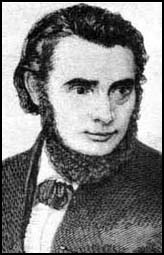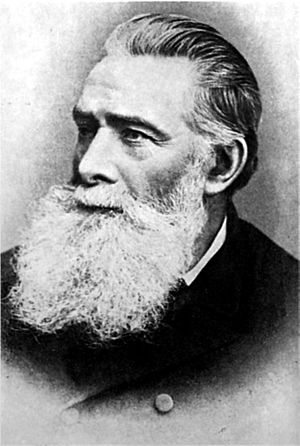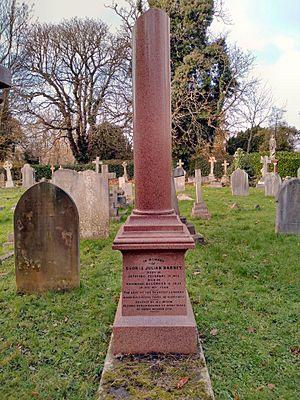George Julian Harney facts for kids
Quick facts for kids
George Julian Harney
|
|
|---|---|

George Julian Harney
|
|
| Born | 17 February 1817 |
| Died | 9 December 1897 (aged 80) |
| Resting place | Richmond Cemetery |
George Julian Harney (born 17 February 1817 – died 9 December 1897) was an important British activist and journalist. He was a key leader in the Chartist movement. This movement worked to give more people the right to vote. Harney also believed in Marxism, socialism, and universal suffrage, which means everyone having the right to vote.
Contents
Early Life and Activism
George Julian Harney was born in Deptford, a part of south-east London. His father was a sailor. When George was eleven, he went to a naval school in Greenwich. But he didn't become a sailor. Instead, he worked for Henry Hetherington, who edited a newspaper called the Poor Man's Guardian. This newspaper was sold without a special tax, which was against the rules at the time. Harney was put in prison three times for selling it.
These experiences made Harney want to change things. He first joined the London Working Men's Association. But he felt they were not moving fast enough to get universal suffrage (the right for everyone to vote). He was inspired by other activists like William Benbow, James Bronterre O'Brien, and Feargus O'Connor.
In 1837, Harney helped start the East London Democratic Association. This group openly supported a republic, meaning a country without a king or queen. Soon, Harney believed in William Benbow's idea that a "Grand National Holiday" (a huge national strike) could lead to big political changes.
Leading the Chartist Movement
At a big Chartist meeting in 1839, Harney and William Benbow convinced others to call for a Grand National Holiday on August 12. Feargus O'Connor disagreed, but he was outvoted. Harney and Benbow traveled around the country, trying to get workers to join the strike.
However, Harney and Benbow were arrested. They were accused of giving speeches that caused trouble. Because of this, the big strike was called off. Harney was held in Warwick Gaol. But when he went to court, the jury decided not to charge him with anything.
After this setback, Harney moved to Ayrshire, Scotland, where he married Mary Cameron. He didn't stay away for long. The next year, he became a Chartist organizer in Sheffield. During the strikes of 1842, Harney was one of many Chartists arrested and tried in Lancaster in 1843. His punishment was later overturned. After that, Harney became a journalist for O'Connor's newspaper, the Northern Star. Two years later, he became its editor.
During this time, Harney was known as a bit of a rebel. He strongly supported using strong actions to achieve the Chartist goals. He often challenged his more cautious friends. He was in and out of jail and sometimes argued with other Chartists. He believed that a big uprising was the best way to get what the Chartists wanted.
Harney was a very important figure in Chartism. He edited the Northern Star for five years (1845–1850). He was one of the few leaders who joined the movement very early on. He had been active in the fight against special taxes on newspapers. He stayed active throughout the time when Chartism had a lot of influence.
Working with Marx and Engels
Harney became interested in how people around the world were fighting for the right to vote. In September 1845, he helped create a group called the Fraternal Democrats. Through this group, Harney met famous thinkers like Karl Marx and Friedrich Engels. Harney even convinced them to write articles for the Northern Star.
In March 1848, Harney was excited by the big changes happening in Europe. He traveled to Paris to meet members of the new French government. His friend, John Bedford Leno, said that Harney knew more about politics in other countries than anyone he knew. Foreign refugees arriving in England often asked where they could find Harney.
Promoting Socialism
Harney became a Socialist. This means he believed in a system where society, not private individuals, owns and controls the means of production and distribution of goods. He used the Northern Star to share these ideas. However, O'Connor, who owned the newspaper, didn't agree with socialism. He pressured Harney to quit as editor.
So, Harney started his own newspaper called the Red Republican. With the help of his friend, Ernest Charles Jones, Harney tried to teach his working-class readers about socialism. He also taught them about workers from different countries working together. In 1847, Harney ran as the Chartist candidate against Lord Palmerston for a seat in Parliament in Tiverton. Harney won the first public vote, but he decided to step down when Lord Palmerston asked for a full election.
In 1850, the Red Republican published the first English translation of The Communist Manifesto. This important book was translated by Helen Macfarlane, a journalist and socialist. The Red Republican didn't make much money and closed in December 1850. Harney then started other newspapers, including the Friend of the People (1850-1852), Star of Freedom (1852), and The Vanguard (1853).
After The Vanguard stopped, Harney moved to Newcastle. He worked for Joseph Cowen's newspaper, the Northern Tribune. After visiting French socialists living in exile, Harney became editor of the Jersey Independent. Harney supported the North in the American Civil War. This upset the owner of the Jersey Independent, and Harney had to resign in November 1862.
Life in the United States and Return to England
In May 1863, Harney moved to the United States. For the next 14 years, he worked as a clerk in the Massachusetts State House. After he retired, he came back to England. He wrote a weekly column for the Newcastle Chronicle newspaper. George Julian Harney passed away on December 9, 1897, at the age of 80. He is buried in Richmond Cemetery in south-west London.
Sources
- http://www.spartacus-educational.com/CHharney.htm
- John Bedford Leno, The Aftermath: With Autobiography of the Author (Reeves & Turner, London 1892)



